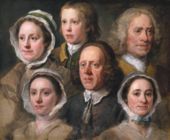Butler/Citable Version: Difference between revisions
imported>Stephen Ewen |
imported>Stephen Ewen (→The butler in "real-life" versus fiction: general factotum) |
||
| Line 81: | Line 81: | ||
"The butler" is integral to the plot of countless potboilers and melodramas, whether or not the character has been given a name. Butlers figure so prominently in period pieces and whodunits that they can be considered stock characters in film and theatre, where a catch phrase is, "The butler did it!" | "The butler" is integral to the plot of countless potboilers and melodramas, whether or not the character has been given a name. Butlers figure so prominently in period pieces and whodunits that they can be considered stock characters in film and theatre, where a catch phrase is, "The butler did it!" | ||
The best-known fictional manservant, and the prototype of the quintessential British butler, is himself not a butler at all. [[Jeeves|Reginald Jeeves]], the iconic creation of author [[P.G. Wodehouse]] is a "gentleman's gentleman" | The best-known fictional manservant, and the prototype of the quintessential British butler, is himself not a butler at all. [[Jeeves|Reginald Jeeves]], the iconic creation of author [[P.G. Wodehouse]] is a "gentleman's gentleman" and general [[factotum]]. [[Alfred Pennyworth]], from ''[[Batman]]'', unusually known as "Alfred" rather than "Pennyworth", "Hudson" of [[Upstairs, Downstairs]] fame, and Crichton from [[J.M. Barrie]]'s ''[[The Admirable Crichton]]'' are probably the best-known fictional butlers. Other lesser-knowns include Lynn Belvedere from the [[novel]] ''[[Belevedere (novel)|Belvedere]]'' (which was adapted into a feature film with sequels and later a [[television series]]); Lurch, from the television series ''[[The Addams Family]]'', Beach, from the Wodehouse series about [[Blandings Castle]], and Benson from the series ''[[Soap (TV series)|Soap]]'' and ''[[Benson (television)|Benson]]''. | ||
Not all fictional butlers portray the "butler stereotype", however. The butler Jennings in the film ''Gosford Park'' was coached by Arthur Inch, a longtime real-life butler. Mr. Stevens, the butler in the film ''Remains of the Day'', was also acted in remarkably true-to-life fashion. | Not all fictional butlers portray the "butler stereotype", however. The butler Jennings in the film ''Gosford Park'' was coached by Arthur Inch, a longtime real-life butler. Mr. Stevens, the butler in the film ''Remains of the Day'', was also acted in remarkably true-to-life fashion. | ||
Revision as of 22:21, 17 August 2007
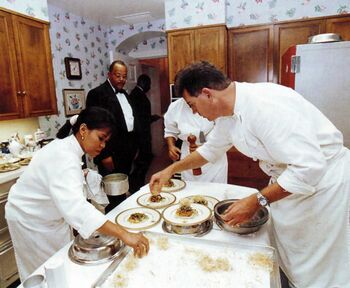
The butler is a senior servant in a well-to-do household. The position has existed for centuries but in modern usage the butler is in charge of food service, is the custodian of wine, spirits, and silver, supervises other servants, and sometimes performs other duties. The butler is usually the most senior staff member, although this too has evolved over time. Today, especially in the grandest homes or when the employer owns more than one residence, there is sometimes an Estate Manager of higher rank than the butler.
In modern houses where the butler is the most senior worker, titles such as Majordomo, Butler Administrator, Staff Manager, and Head of Household Staff are sometimes used.
In the great houses of the past, the household was generally divided into areas of responsibility, with the butler in charge of the dining room (including the wine cellar) and pantry, and sometimes the entire main floor, while a housekeeper was in charge of the house as a whole and also its appearance.[1] Housekeepers are occasionally portrayed in literature as being the most senior staff member and even as making recommendations for the hiring of the butler.[2]
Origin and development of the post of butler
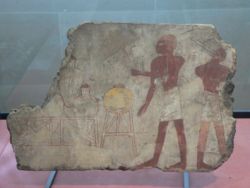
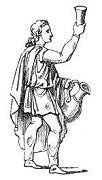
The modern role of the butler has evolved from earlier roles that were generally concerned with the care and serving of alcoholic beverages.
Ancient and medieval eras
From ancient through medieval times, alcoholic beverages were chiefly stored first in earthenware vessels, then later in wooden barrels, rather than in glass bottles; these containers would have been an important part of a household's possessions. The care of these assets was therefore generally reserved for trusted slaves, although the job could also go to free persons because of heredity-based class lines or the inheritance of trades.
The biblical book of Genesis contains references to roles precursive to modern butlers. The early Hebrew Joseph interpreted a dream of Pharaoh's שקה (shaqah) (literally "to give to drink"), which is most often translated into English as "chief butler" or "chief cup-bearer".[3]
In ancient Greece and Rome, it was nearly always slaves who were charged with the care and service of wine, while during the European Middle Ages the pincerna, usually a serf, filled the role.
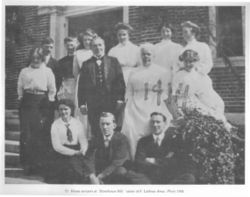
The English word "butler" itself derives from the Middle English word boteler (and several other forms), from Old French bouteillier ("bottle bearer"), and before that from Middle Latin butticula. "Butticula", in turn, came down to English as "butt" from the Latin buttis, meaning a large cask. The modern English "butler" thus relates both to bottles and casks.
Eventually the European butler emerged as a middle-ranking member of the servants of a great house, in charge of the buttery (originally a storeroom for "butts" of liquor, although the term later came to mean a general storeroom or pantry).[4] While this is so for household butlers, those with the same title but in service to the Crown enjoyed a position of administrative power and were only minimally involved with various stores.
Nineteenth century and the Victorian era
Gradually, throughout the nineteenth century and particularly the Victorian era, as the number of butlers and other domestic servants greatly increased in various countries (including America), the butler became a senior male servant of a household's staff. By this time he was in charge of the more modern wine cellar, the "buttery" or pantry (from French pan from Latin panis, bread) as it came to be called, which supplied bread, butter, cheese, and other basic provisions, and the ewery, which contained napkins and basins for washing and shaving.[5] In the very grandest households there was sometimes an Estate Steward or other senior steward who oversaw the butler and his duties.[6] In 1861 a British manual on households reported:
The number of the male domestics in a family varies according to the wealth and position of the master, from the owner of the ducal mansion, with a retinue of attendants, at the head of which is the chamberlain and house-steward, to the occupier of the humbler house, where a single footman, or even the odd man-of-all-work, is the only male retainer. The majority of gentlemen's establishments probably comprise a servant out of livery, or butler, a footman, and coachman, or coachman and groom, where the horses exceed two or three.[7]
Butlers in early America From the beginning of slavery in America, in the early 1600s, African Americans were put to task as domestic servants, some eventually becoming butlers. Gary Puckrein, a social historian, argues that those used in particularly affluent homes authentically internalised the sort of "refined" norms and personal attributes that would reflect highly upon the social stature of their masters or mistresses. One of the first books written and published through a commercial U.S. publisher by an African American was by a butler named Robert Roberts. The book, The House Servant's Directory (see link to full text at bottom of page), first published in 1827, is essentially a manual for butlers and waiters, and is called by Puckrein "the most remarkable book by an African American in antebellum America". The book generated such interest that a second edition was published in 1828, and a third in 1843.[8] European indentured servants formed a corps of domestic workers from which butlers were eventually drawn. Although not the victims of institutionalised slavery, many of these had not volunteered for domestic service, but were forced into it by indebtedness or coercion. As with African American slaves, they could rise in domestic service, and their happiness or misery depended greatly on the nature of their masters. |
Typically, the butler was hired by the master of the house but he usually reported to its lady. In the largest of households, the butler was head of a strict service hierarchy and therein held a position of power and respect. Such butlers engaged and directed all junior staff. Butlers were addressed by last name alone by their employers and their employers' children and guests, but as "Mr. [Surname]" by fellow servants, retainers, and tradespersons. These butlers were more managerial than "hands on": they officiated in service rather than actually serving. For example, although the butler was at the door to greet and announce the arrival of a formal guest, the door was actually opened by a footman, who would receive the guest's hat and coat. Even though the butler helped his employer into his coat, this had been handed to him by a footman. However, even the highest-ranking butler would "pitch in" when necessary (such as during a staff shortage) to ensure that the household ran smoothly.
The butler engaged the footmen and assigned their duties. Footmen reported directly to the butler; the first footman (or head footman) was deputy or under-butler and filled in as butler during the butler's illness or absence. In a household without an official Head Housekeeper, female servants and kitchen staff were also directly under his management. In smaller households, on the other hand, the butler usually acted as valet for his employer.
The modern butler
Beginning around the early 1920s, employment in domestic service occupations began a sharp overall decline in western European countries, and even more markedly in the United States. Even so, there were still around 30,000 butlers employed in Britain by World War II. Only a hundred or so remained by the mid-1980s.[9] Social historian Barry Higman argues that a high number of domestic workers within a society correlates with a high level of socio-economic inequality. Conversely, as a society undergoes levelling among its social classes, the number employed in domestic service declines.[10]

Following varied shifts and changes accompanying accelerated globalisation beginning in the late 1980s, overall global demand for butlers since the turn of the millennium has risen dramatically. According to Charles MacPherson, vice chairman of the International Guild of Professional Butlers, the proximate cause is that the number of millionaires and billionaires has increased in recent years, and such people are finding that they desire assistance in managing their households. MacPherson emphasises that the number of wealthy in China has particularly increased, creating in that country a high demand for professional butlers who have been trained in the European butlering tradition.[11] There is also high demand for such butlers in petroleum-rich Middle Eastern countries.
Higman additionally argues that the inequality/equality levels of societies are a major determinant of the nature of the domestic servant/employer relationship.[12] As the 21st century approached, many butlers began carrying out an increasing number of duties formerly reserved for more junior household servants. Butlers today do whatever household and personal duties their employers deem fitting, in the goal of freeing their employers to carry out their own personal and professional affairs. Author Steven M. Ferry states that the image of tray-wielding butlers who specialise in serving tables and decanting wine is now anachronistic, and that employers may well be more interested in a butler who is capable of managing a full array of household affairs—from providing the traditional dinner service, to acting as valet, to managing high-tech systems and multiple homes with complexes of staff. Whilst in truly grand houses the modern butler may still function exclusively as a top-ranked household affairs manager,[13] in lesser homes they perform a full array of household and personal assistant duties,[14] including mundane housekeeping.[15] Butlers today may also be situated within corporate settings, embassies, and yachts, or within their own small "Rent-a-Butler" business or similar agency.
In ancient times, the roles precursive to butlering were reserved for chattel or those confined within heredity-based class structures. With the advent of the medieval era, butlering became an opportunity for social advancement—even more so during Victorian times. Although still based upon various antecedent roles as manifested during different eras, butlering today has frequently taken over many of the roles formerly reserved for lower ranking domestic servants. At the same time it has become a potentially lucrative career option.[16]
Gender and butlering
Butlers have traditionally been male, and this remains the norm. Probably the first mention of a female butler is in the 1892 book Interludes being Two Essays, a Story, and Some Verses by Horace Smith (see link to full text below). In it Smith quotes a Sydney Smith who had apparently run into hard times:
A man servant was too expensive, so I caught up a little garden girl, made like a milestone, christened her Bunch, put a napkin in her hand, and made her my butler. The girls taught her to read, Mrs. Sydney to wait, and I undertook her morals. Bunch became the best butler in the country.[17]
Today, female butlers are sometimes preferred; an example would be in cultures where it is unacceptable to have males working intimately with females in a household.[18] The International Guild of Professional Butlers states that there is a "definite demand" for females in the profession, as Middle and Far Eastern families often prefer female butlers, as do female celebrities.[19] Despite this, the Ivor Spencer School asserts that, on the whole, female butlers are not easily placed.
Butler training
In times past, butlers earned their position by working their way up the service ladder. In the documentary The Authenticity of Gosford Park, former butler Arthur Inch describes starting as a hall boy.[20] Today, however, there are numerous private butlering schools; top graduates can start at USD 50,000 - 60,000.[21] Additionally, major up-market hotels such as the Ritz-Carlton offer traditional butler training, whilst some hotels have trained a sort of pseudo-butler for service in defined areas such as "technology butlers", who fix guests' computers and other electronic devices, and "bath butlers" who draw custom baths.[22]
Some schools distinguish between the "British butler" prototype and its American counterpart, often dubbed the "household manager". Starkey International, for example, state that they train and promote the latter, believing that Americans do not have the "servant mentality" that is part of the British Butler tradition. They stress that their American-style butlers and valets are educated and certified,[23] although some students, numerous former Starkey employees, and several wealthy clients have criticised the programme and its owner.[24]
In addition to formal training, a few books have been published recently to assist butlers in their duties. Moreover, websites, as well as a news publication, Modern Butlers' Journal, help butlers to network and keep abreast of developments within their field.
Butlers in art Butlers have been occasionally depicted in art.[25] A famous painting, Heads of Six of Hogarth's Servants, is unique among such works. In it, the 17th-century English artist William Hogarth depicted his household servants, each surrounding the butler. In showing the group in a close-knit assemblage rather than in the performance of their routine household duties, Hogarth sought to humanise and dignify them in a manner akin to wealthy-class members, who were the normal subjects of such portraits. Whilst this was a subversive act that certainly raised many eyebrows in his day—Hogarth conspicuously displayed the work in his estate home in full view of guests—at the same time he had painted his servants' facial expressions to convey the sincerity and deference expected of servant-class members. Photo: Tate Collection, U.K. |
Ferry argues that what he calls a butler "mindset" is beneficial to all people within all professions. He states that an attitude of devoted service to others, deference, and the keeping of confidences can help all people succeed.
The butler in "real-life" versus fiction
- For a comprehensive listing of butlers and valets with notes, see Catalog of butlers and valets.
The real-life modern butler attempts to be discreet and unobtrusive, friendly but not familiar, keenly anticipating and meeting the needs of his or her employer, and executing those duties with the utmost grace and precision. The butler in fiction, by contrast, is larger-than-life and has become a traditional "plot device" in literature and the performing arts. Butlers often provide comic relief, with wry comments or clues to the perpetrators of various crimes, and they are represented as being at least as intelligent as their "betters", and sometimes a lot smarter. Butlers in fiction almost invariably follow the "British butler" model, with an appropriate-sounding surname. The Asian, African American, or Caribbean houseboy is a variant, but even these major-domos are based on the British icon.
"The butler" is integral to the plot of countless potboilers and melodramas, whether or not the character has been given a name. Butlers figure so prominently in period pieces and whodunits that they can be considered stock characters in film and theatre, where a catch phrase is, "The butler did it!"
The best-known fictional manservant, and the prototype of the quintessential British butler, is himself not a butler at all. Reginald Jeeves, the iconic creation of author P.G. Wodehouse is a "gentleman's gentleman" and general factotum. Alfred Pennyworth, from Batman, unusually known as "Alfred" rather than "Pennyworth", "Hudson" of Upstairs, Downstairs fame, and Crichton from J.M. Barrie's The Admirable Crichton are probably the best-known fictional butlers. Other lesser-knowns include Lynn Belvedere from the novel Belvedere (which was adapted into a feature film with sequels and later a television series); Lurch, from the television series The Addams Family, Beach, from the Wodehouse series about Blandings Castle, and Benson from the series Soap and Benson.
Not all fictional butlers portray the "butler stereotype", however. The butler Jennings in the film Gosford Park was coached by Arthur Inch, a longtime real-life butler. Mr. Stevens, the butler in the film Remains of the Day, was also acted in remarkably true-to-life fashion.
References
- ↑ Post, Emily (1997). Emily Post's Etiquette. Collins. ISBN 0062700782.
- ↑ 18th-century housekeepers sometimes made extra money by giving tours of the great house, a fact depicted in Jane Austen's Pride and Prejudice.
- ↑ Genesis 39-40.
- ↑ This was most likely from a loss of the original Latin meaning and the mistaken belief that buttery related to "butter".
- ↑ Nancy Scanlon (2006). "The Development of the Kitchen in the English Country House 1315-1864". Journal of Culinary Science & Technology 4 (2/3).
- ↑ Beeton, Isabella (1861) (2000). Mrs Beeton's Book of Household Management. Oxford University Press, 393. ISBN 0192833456.
- ↑ Beeton (1861), 393.
- ↑ Gary Puckrein (Oct/Nov 98). "The Science of Service". American Visions 13 (5).
- ↑ J. Lee (1988). "Steady, Jeeves—you've got company!". U.S. News & World Report 104 (17).
- ↑ Higman, Barry (2002). Domestic Service in Australia. Melbourne University Publishing. ISBN 0522850111.
- ↑ Scott Simon (10 Feb 2007). By Jeeves, We're Having a Butler Shortage—Interview with Charles MacPherson (Streaming Audio). Weekend Edition Saturday. NPR News. Retrieved on 2007-08-13. Also see Sheelah Kolhatka, "Inside the Billionaire Service Industry". The Atlantic, Sept 2006, 97-101. Archived.
- ↑ Higman (2002)
- ↑ Ferry, Steven M.. Butlers & Household Managers: 21st Century Professionals. BookSurge Publishing, 14. ISBN 1591093066.
- ↑ William Loeffler (15 April 2007). "The butler does it". The Pittsburgh Tribune-Review, Lifestyle.
- ↑ James Woodford (2007-08-13). "Move over, Jeeves, a new breed of butler is working her way up". The Sydney Morning Herald. Archived. Elizabeth Camille, a butler in Sydney, states, "I still make beds, clean toilets and peg out washing.... It's not all as glamourous as people perceive it to be." Additionally see "Desperately seeking Jeeves", The Globe and Mail (Canada), 20 July 2007. Lynda Reeves, president of the Toronto-based House & Home Media, says that the term "butler" today is just "a pretentious name for a housekeeper".
- ↑ In Loeffler (15 April 2007), Nathalie Laitmon of The Calendar Group in Stamford, Connecticut, states that skilled butlers within the grandest households can make USD 200,000. She states, "The bigger the lifestyle of the family, the more they can earn".
- ↑ Smith, Horace; Joel Lehtonen (translator) (1892). Interludes being Two Essays, a Story, and Some Verses. MacMillan & Co.. ISBN 1406919659.
- ↑ For interesting background, see Elizabeth Warnock Fernea, Guests of the Sheik: An Ethnography of an Iraqi Village. Anchor, 1995. ISBN 0385014856.
- ↑ See The International Butler's Guild.
- ↑ The Authenticity of Gosford Park, Documentary featurette in Gosford Park Collector's Edition DVD, Universal Studios, 2002.
- ↑ Simon (10 Feb 2007).
- ↑ Witchel (2000). "At Hotels, the Butlers Are Doing It". New York Times 149 (51486). Ferry, as quoted in "Desperately seeking Jeeves", The Globe and Mail (Canada), 20 July 2007, contends that hotel butlers are not rooted in the European tradition of butlering. He states that hotels essentially rename their pool attendants as "butlers".
- ↑ Starkey does lay claim to understanding the British butler tradition; however, her general approach seems to be that American domestic staff are better suited to American families,
- ↑ Joel Warner (9 Aug 2007). "At Your Disservice". Denver Westword News. Archived.
- ↑ Waterfieldm G., A. French and M. Craske, Eds. (2003). Below stairs, 400 years of servants' portraits. London: National Portrait Gallery. ISBN 185514512X.
External links
Butlering organizations
Butlering publications
Butler training
- The Australian Butler School
- The Butler Valet School
- The International Butler Academy
- The International Institute of Modern Butlers
- Starkey International
Links to full text
- The House Servant's Directory by Robert Roberts
- Interludes being Two Essays, a Story, and Some Verses by Horace Smith
Other
Bibliography
- Beeton, Isabella. Mrs Beeton's Book of Household Management. 1861 abridged edition by Nicola Humble, Oxford University Press, 2000. Online edition. ISBN 0192833456.
- Fauve-Chamoux, A., Ed. Domestic service and the formation of European identity. Understanding the globalization of domestic work, 16th–21st centuries. Peter Lang, Bern, 2004.
- Ferry, Steven M. Butlers & Household Managers: 21st Century Professionals. BookSurge Publishing, 2005. ISBN 1591093066.
- Frank, Robert. Richistan: A Journey Through the American Wealth Boom and the Lives of the New Rich. Crown, 2007. ISBN 0307339262.
- Higman, Barry. Domestic Service in Australia. Melbourne University Publishing, 2002. ISBN 0522850111.
- Hill, Bridget. Servants: English Domestics in the Eighteenth Century. Oxford University Press, 1996. Online edition.. ISBN 0198206216.
- Meldrum, Tim. Domestic Service and Gender, 1660-1750: Life and Work in the London Household. Longman, 2000. ISBN 0582312086.
- Waterfield, G., A. French and M. Craske, Eds. Below stairs, 400 years of servants' portraits. National Portrait Gallery, London, 2003. ISBN 185514512X.

